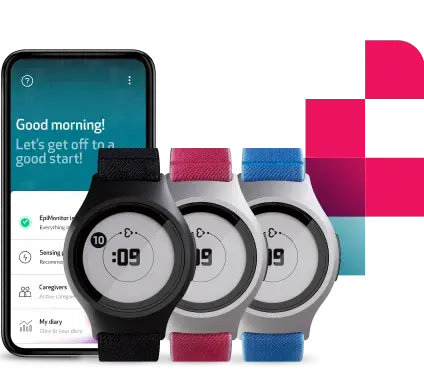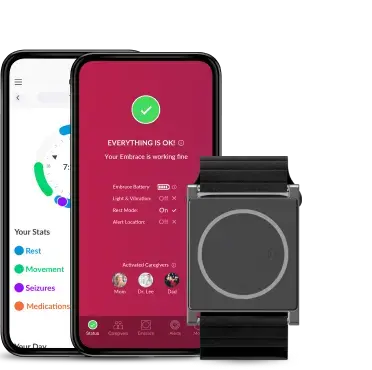How the Alert System works: Staying connected to your Embrace
Imagine Embrace2 as a tool, one that can make living with epilepsy a lot easier. Understanding how it works will make all the difference. Just like when you were little and learning how to ride a bike, first you learn about balance and braking before starting to pedal.
Read on to learn everything you need to know in order to use your Embrace2 with confidence. We think you’ll be surprised by how simple it actually is.
What does Embrace2 do?
FDA-cleared for both children (ages 6 and up) and adults, Embrace2 works together with your smartphone to alert your caregivers when it detects a possible tonic-clonic seizure. It’s like a vigilant guard, always on its toes for strange movements and changes in physiological signals. When these occur, it cannot send a message on its own. Embrace needs to be connected to your smartphone via Bluetooth, and your smartphone needs to be connected to the Internet in order to deliver an SMS and phone call to your caregivers.
While your phone and Embrace must always remain close to communicate, your caregivers’ phones can be at any distance. For example, let’s say a seizure occurs while you’re at home relaxing and watching TV with your phone right by your side. Embrace detects it, and communicates to your phone to send the alert. Your caregivers could be at work or even at the beach, and they’ll still receive the alert call and SMS. And they don’t need to download any special apps.
Ok, so what’s behind this magic?
The first thing to know: Bluetooth
Bluetooth technology allows two devices within short range of each other (usually less than 30 feet or 10 meters) to communicate without the need for a cable. Some of the most common uses for Bluetooth are headphones, keyboards, and computer mice. Bluetooth-connected devices communicate wirelessly over radio waves. These radio waves can be obstructed, however, even if the two devices are close to each other.
Here are some common things that lead to obstructions in the Bluetooth signal.
- Walls (So if you’re wearing Embrace, and you go into another room, you should take your phone with you).
- Heavy fabric or material (Try not to sleep with your arms underneath your pillow).
- The human body (Also while sleeping, try not to place your arms between your legs or under your head).
- Distance (Try to always stay within 30 feet/10 meters of your phone).
Some users might find it tricky to keep Embrace within Bluetooth range of the paired smartphone, especially if the Embrace user is a young kid. In this case, we suggest using a running belt to keep the smartphone inside to make sure that the two devices are always in range.
A young child may not have a phone of their own to pair Embrace with. Some parents have tried pairing Embrace with their own phone, but this often leads to disconnections. Anytime the parent needs to step out of the room to take a call, there would be a disconnection. If Embrace is being used at night, the parent would have to leave their phone in the child’s room and rely on another phone in the house to receive alerts.
What happens if there is a Bluetooth disconnection?
Embrace will light up with a Red X to let you know. If you were too far away from your phone, you just need to go back within range, and Embrace will automatically reconnect, flashing a white smile on its surface.
If you’re using the Mate App to keep track of your rest and physical activity, they will still be recorded on Embrace’s internal memory during the disconnection. So, if you go on a walk with your friend, but forget your phone at home, the physical activity will still be recorded for up to 14 hours. Beyond this, Embrace won’t be able to record any more information. If there is a Bluetooth disconnection, possible seizures can still be detected by Embrace, but it can’t communicate to the Alert App to send the alerts. Once you reconnect to your phone, the data will flow to the Alert App, then to our servers for processing, and finally to Mate so you can view it to see cool details like distance covered and step count. To avoid filling up Embrace’s memory, just remember to always keep your phone close by.
See how we recently redesigned Mate to help you better understand your data.
What happens if a seizure is detected and Embrace is disconnected?
Because of the disconnection, Embrace cannot communicate with your phone. If it cannot communicate with your phone, it cannot tell it to call and text your caregivers. It will attempt to send the alerts for one minute in case you’re able to reconnect. So let’s say that you started having a seizure; you were asleep, and your arm was underneath the pillow. Embrace still detects the convulsive movements, and it attempts to communicate with your phone. Let’s say that 10 seconds later, as you’re having the seizure, your arm moves and is no longer underneath the pillow. In this case, Embrace automatically reconnects with your phone letting it know that a seizure has been detected and triggers it to send the text message and phone call.
Let’s change the scenario just a bit. Let’s say that the arm was moved from under the pillow after 2 minutes. Embrace would have stopped attempting to communicate with the phone, and the alerts would not have been sent.
The moral of the story is that Bluetooth is critical, so just keep distance in mind, watch out for obstructions, and always have your phone handy.
The second thing to know: Internet connection
Okay, so now we know how Embrace communicates with your phone, but how does your phone communicate with your caregivers? How does it send the text message and alert call? Does your phone need to have cellular signal?
Nope, but it absolutely needs to be connected to a stable and reliable internet connection. This can be either WiFi or cellular data.
Of course, you also have to download the Alert App, which is responsible for sending the alerts and informing you of all important things related to your Embrace. Caregivers however do not need to download any apps, nor do they need internet connection to receive the alerts.
When your phone isn’t connected to internet, you’ll receive a notification on your phone from the Alert App, and the main screen of the app will contain the same message, accompanied by a big red X.
Up next: False alarms
Embrace is your vigilant guard, always on the lookout for signs that could indicate a tonic-clonic seizure. We’ve trained it with very specific instructions on when to call for help. Some activities, however, such as brushing your teeth and scrubbing dishes, have movements that are very similar to those of a seizure. To be on the safe side, Embrace will alert for these too. It’s normal, and you don’t have to worry.
Our next post will tell you more about false alarms including how to cancel them, and even prevent some.
Considering Embrace2 for your child? Check out our blogpost on the topic!
Many disconnections can be solved by just keeping the above tips in mind. We hope that understanding how Embrace stays connected to its paired phone makes you feel more confident in using it and prevents disconnections from happening in the first place.
One more thing, don’t forget to check out our animated video explaining how Embrace works. We worked very hard on it, and we are excited to share it with the world! Read more about it in the blog.
Words worth reading
We do not guarantee that EpiMonitor will detect every single seizure and deliver alerts accordingly. It is not meant to substitute your current seizure monitoring practices, but rather to serve as a supplement in expediting first-response time.



